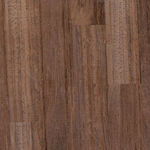Serving Upstate NY—VT—MA • For selections & prices, CALL or EMAIL US
Peruvian Walnut (Nogal)
Grades & Properties of Wood Flooring —
Exotic Species
Scientific Name:
Juglans neotropica
Other Common Names and Related Species:
- Andean Walnut
- Cedro Negro
- Cedro Nogal
- Colombian Walnut
- Ecuadorian Walnut
- Nogal
- Nogal Blanco
- Nogal Bogotano
- Nogal Silvestre
- Nuez Meca
- Tocte
- Tropical Walnut
Shop online now for Peruvian Walnut Flooring »
Origin:
Peru, Brazil, and throughout parts of South America.
Janka Hardness: 1080
Peruvian Walnut (or Nogal) is very similar in hardness and appearance to its northern relative, the American Walnut.
Grades of Peruvian Walnut Flooring:
Clear grade Peruvian Walnut flooring is color-sorted for a rich consistent deep brown color. Peruvian Walnut is a dark-colored wood and is normally only available in Clear grade. Nogal gets its nickname (“Peruvian Walnut”) from its close resemblance in color to American Walnut, to which it is related. Only the heartwood of the tree is used in the Clear grade. Peruvian Walnut is much more brown in color than Brazilian Cherry and darker than Brazilian Walnut. Some green streaking can be present in the wood, which is usually separated out of the Clear grade.
Peruvian Walnut Flooring Dimension Specifications:
Most South American flooring is milled in South America because it is more cost-effective to ship finished material than raw lumber. Lengths of the Brazilian flooring bundles are 7 feet so they can easily fit into 8-foot-wide steel shipping containers. All pre-milled products are tongue-&-groove and end-matched (tongue-&-grooved on the ends of the boards). Moisture content ranges from 6% to 8% for quick acclimation. The average length of the flooring pieces is usually about 3 feet and ranges from 1 to 7 feet. Almost all imported flooring that is found is in 7-foot bundles, with widths available from 2¼″ to 5″. If a long or wide plank floor is desired, raw lumber must be obtained and the flooring must be milled here in the United States. Peruvian Walnut flooring is not typically milled into flooring in South America. The flooring is imported in lumber form and milled in the U.S., so most Peruvian Walnut is made in a long plank. Typically, the lengths can develop up to 12 feet. However, the cost can be double that of a pre-milled product because of waste and labor costs in the United States. Also, raw lumber is relatively expensive because it is taxed more heavily than finished products to support local economies in South America.
Flooring Availability:
Peruvian Walnut is usually only available in solid unfinished form and in a long plank. Prefinished solid or engineered is an extreme custom order. Peruvian Walnut is a less common species in comparison with Brazilian Cherry and Brazilian Teak. There is a fairly large amount of Peruvian Walnut in South America, and it is not endangered. However, less logging, stricter regulations, the decking market, and a slower American economy have limited commodities and caused slightly higher prices of this product in this country.
Finished Floor Appearance:
A Clear grade floor will have a very even dark brown appearance similar to American Black Walnut, but darker and more uniform. Oil-based finishes allow Peruvian Walnut to age to a deep brown color. Lacquer or de-waxed shellac can be first applied to help preserve the distinctive brownish color of the wood and will help with drying time. Water-based finishes will preserve the natural color longer but may appear milky in appearance because of Peruvian Walnut’s dark color.
Flooring Durability and Stability:
Peruvian Walnut flooring is not as durable as Brazilian Walnut and can dent rather easily in comparison. It is relatively stable in comparison to Maple or Hickory. Peruvian Walnut flooring is comparatively light, weighing less than 3 pounds per square foot.
Workability of Peruvian Walnut Flooring:
Being somewhat soft, Nogal works with no difficulty with both hand and power tools. When installing the Peruvian Walnut flooring, a manual nailer, staples, and pneumatic nailers can be used without problems. It holds screws well, and it glues, stains, and polishes to a very attractive finish. It can be somewhat difficult to sand with flooring equipment because of its softness. Professional sanding and finishing is recommended.
Principal Uses of Peruvian Walnut Flooring:
Nogal flooring is used in medium- and high-end residential and commercial applications for a dramatically elegant floor. It is also used for color-contrasting borders and medallions.





